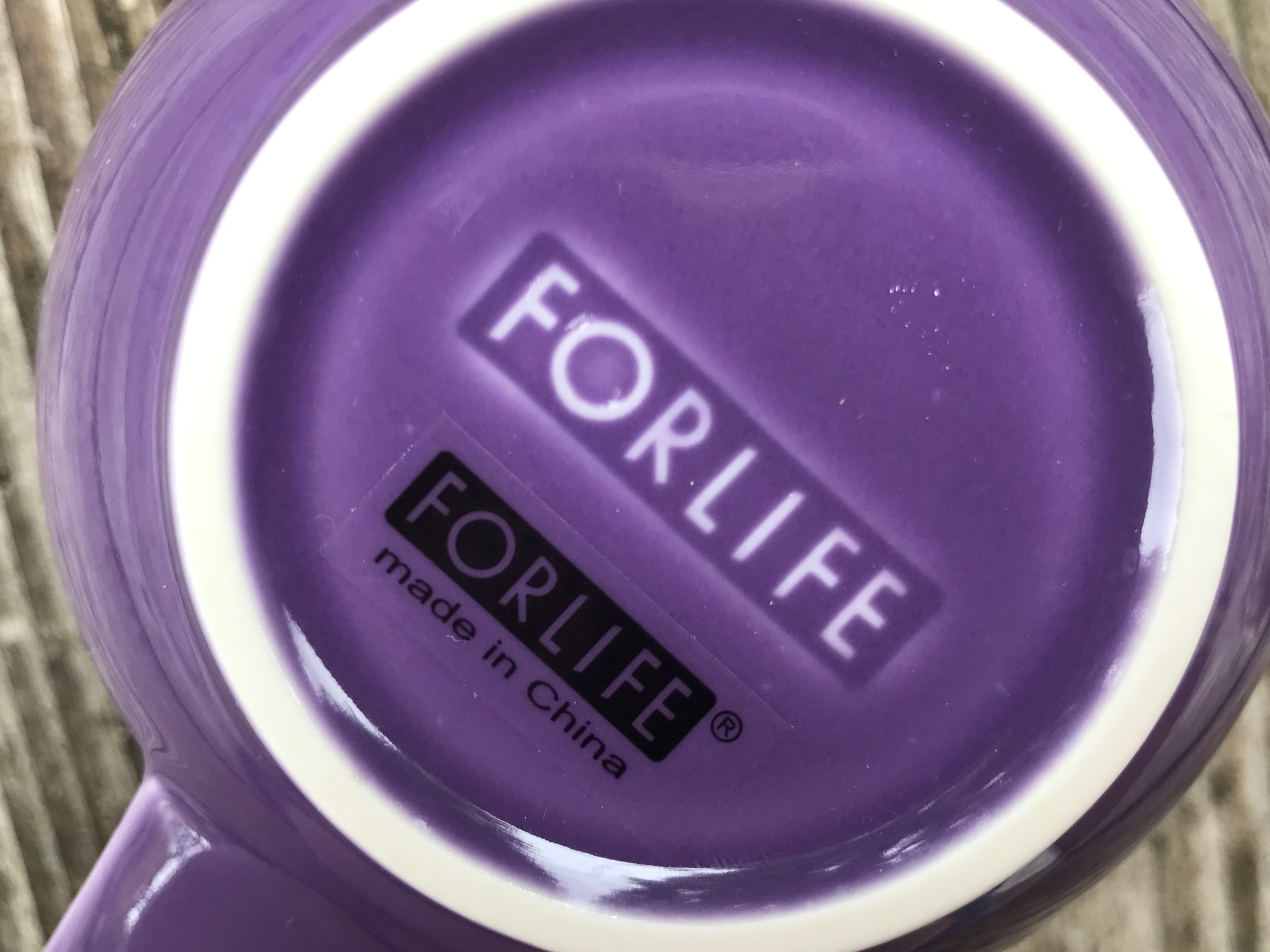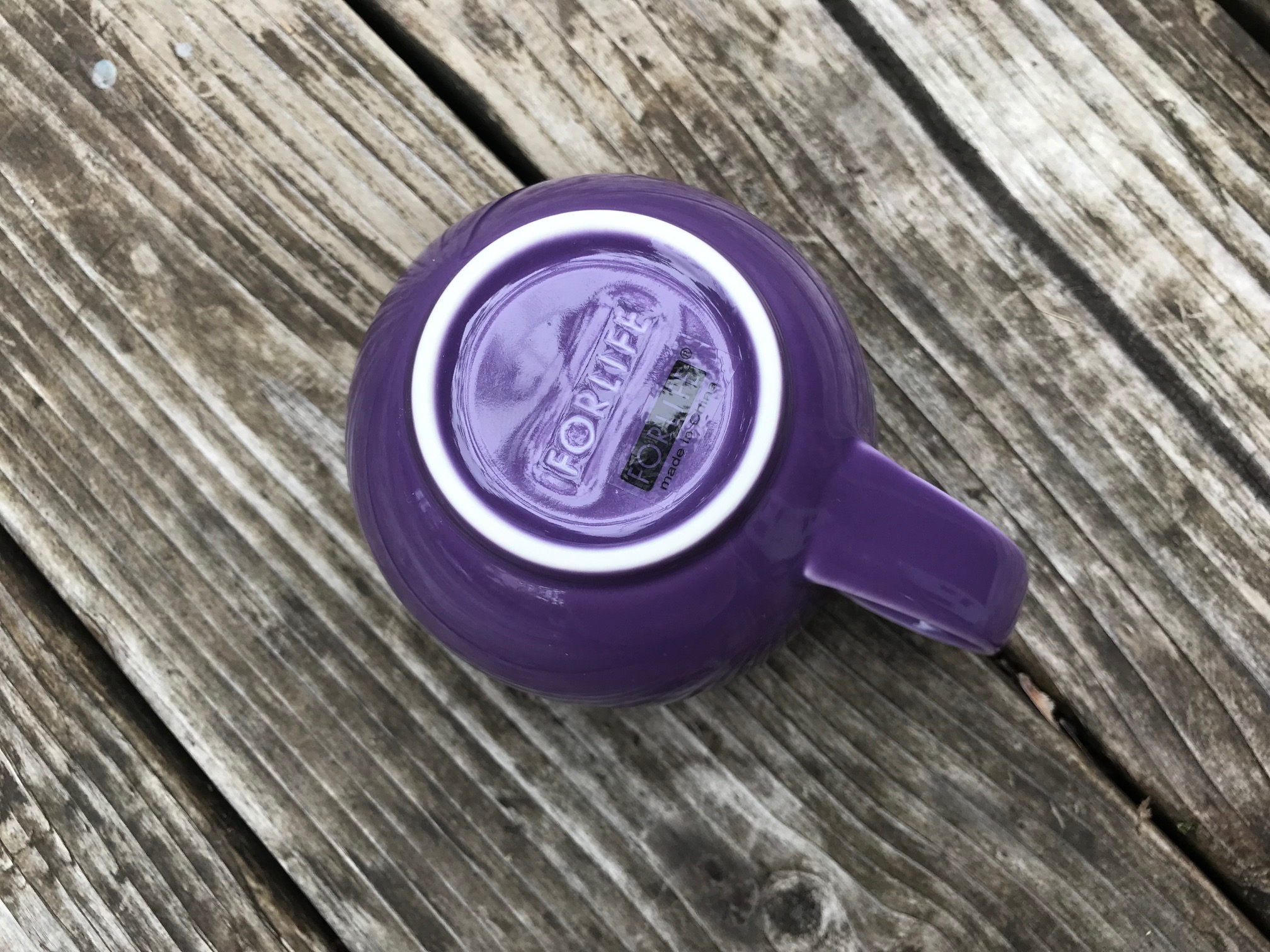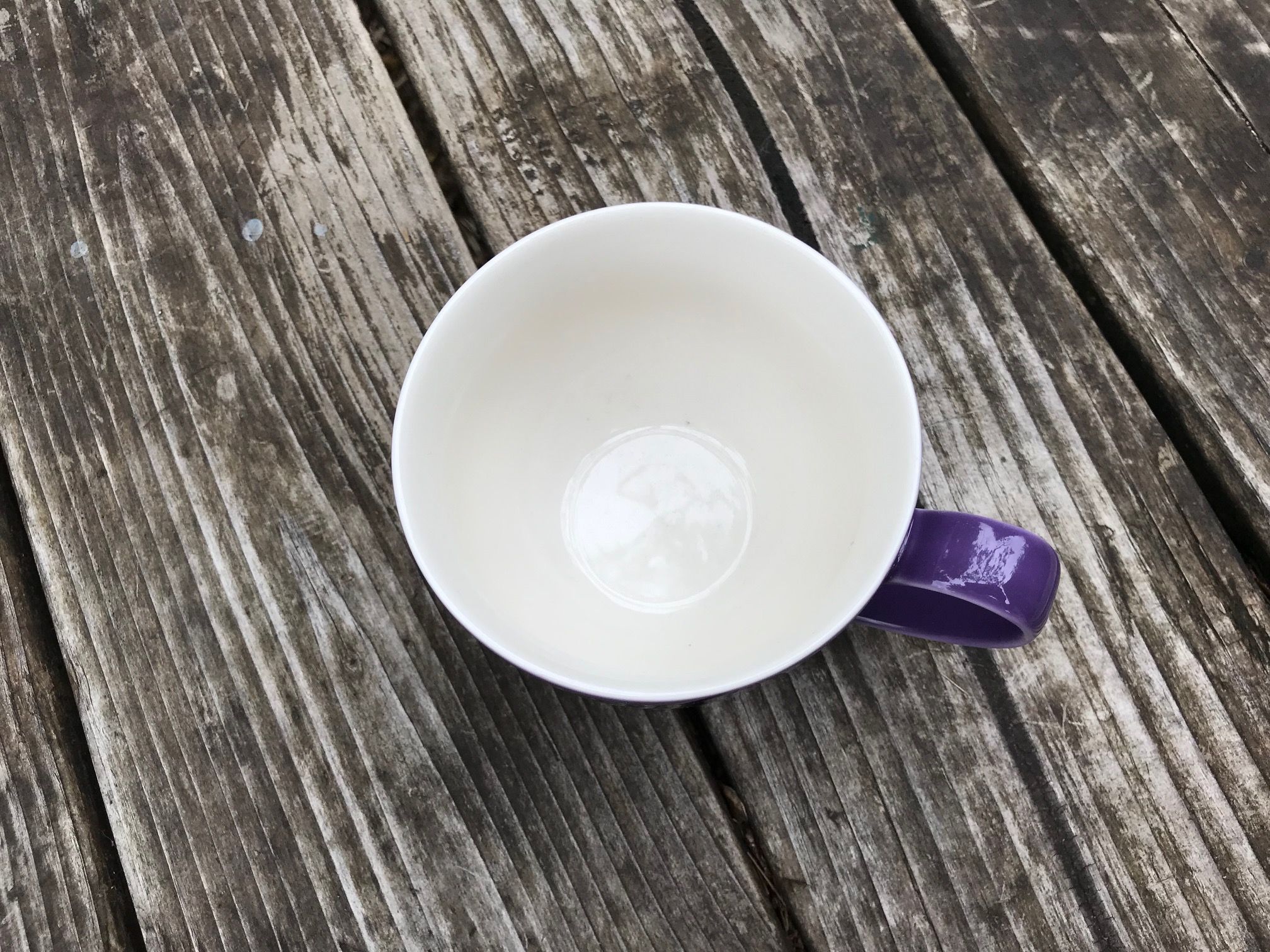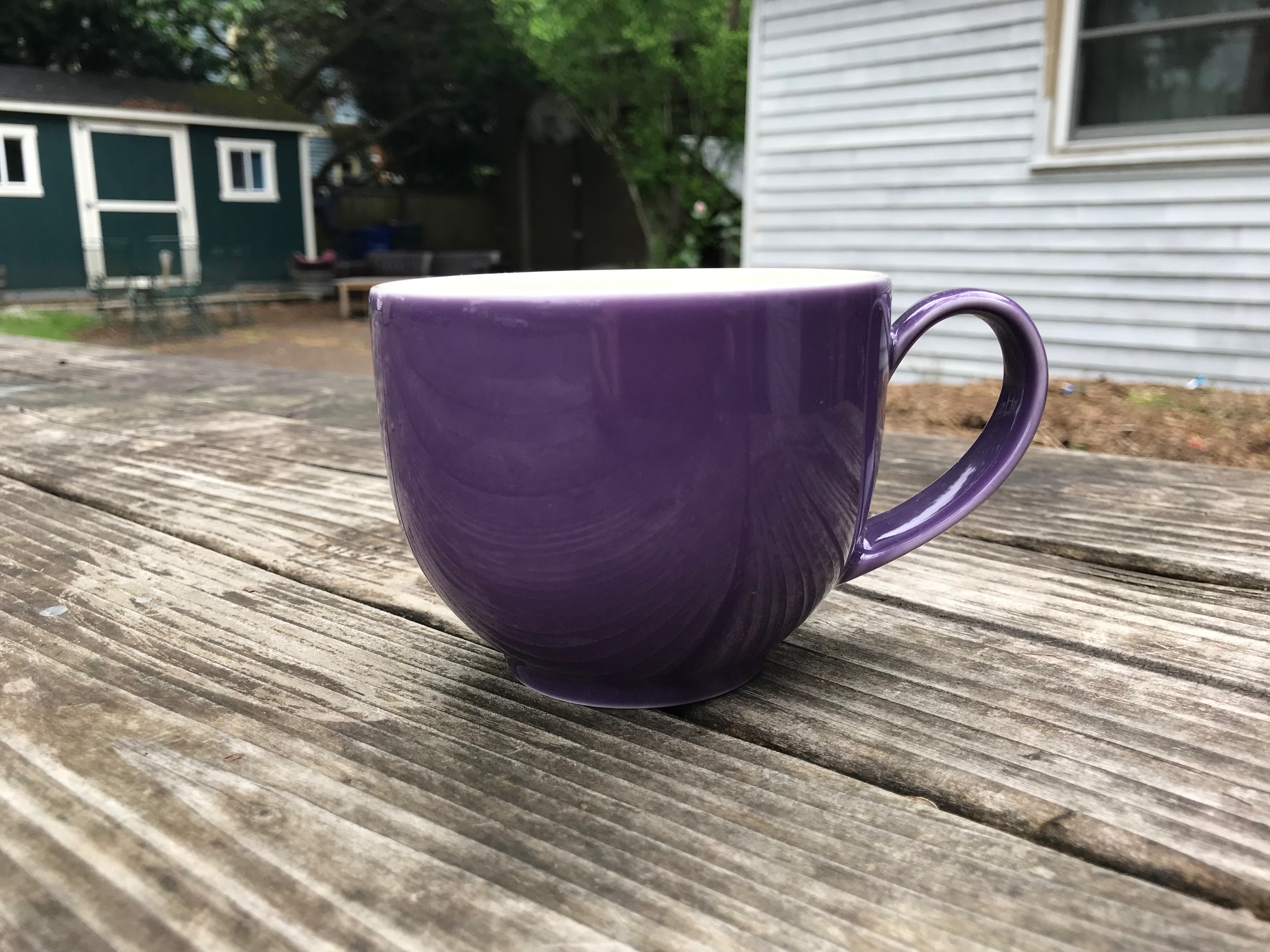One of my most disappointing finds recently: purple 2019 ForLife Q Tea Cup w Handle “lead-free” mug: 541 ppm Lead
This story is a perfect example of why I hate recommending any mass-produced product!…
Earlier this year (2019) I bought a set of these mugs [ ForLife Q Tea Cup with Handle 10 ounce purple mugs ] as a birthday gift for my good friend Carissa (because I had tested a cute unicorn mug of hers and it had tested positive for Cadmium and Lead — and I felt bad about having to deliver that disappointing news, and wanted to “make up” for that!)
Now, you gotta get, that, up to this point I had recommended this brand – for years — because every single ForLife mug that I had ever tested prior to this was completely Lead-free [not only did they they explicitly advertise their product as Lead-free (indicating this was intentional, and a manufacturing choice and company standard) but also, every one I had ever tested had also tested 100% negative — not only for for Lead, but all the other common heavy metal toxicants (using an XRF instrument in Consumer Goods mode) — on both the inside and outside surfaces [heck, the mug I myself drink my coffee out of every day is a ForLife mug]!
Of course, because I am…well…me, even with my knowledge that these products are generally Lead-free, I had to dutifully go ahead and test these particular three mugs before giving them to one of my best friends “just to be sure” — and was surprised (and so sad and disappointed) that they were positive for Lead!
Obviously, although I have liked and recommended their products in the past, and despite their previous great record, I can’t in good conscience continue to heartily recommend their products at this point. As both a Lead-poisoning prevention advocate, and an environmental activist, ANY Lead in consumer products – specially those that come into contact with food – is a problem for me; Lead in a mug advertised and marketed as “Lead-free” is a much bigger problem, though. I do realize and appreciate how difficult and costly it can be to monitor/test/confirm and maintain quality control in today’s long and internationally-fluid supply chains — but that is the heavy burden of responsibility that is assumed when producers commit to advertising/marketing products on the basis of claims like “Lead-free”, “heavy metals-free”, “non-toxic”, etc., and then subsequently violate their customers’ trust [as well as the potential environmental and worker safety impact; adding to consumers’ cumulative body burdens of exposure to neurotoxicants, etc.] by failing to consistently live up to those claims (for whatever reason).
Unfortunately, these incidents have been a recurring theme on my blog over the years (companies failing to live up to their “Lead-free” claims; some through honest mistakes, or flawed Quality Assurance programs, or misplaced trust in the claims of subcontractors or suppliers — and others for more fundamentally disturbing reasons).
But why is this a problem?
So, while they are not in fact “Lead-free”, as confirmed by testing with an XRF instrument, it is highly likely that they did pass leach-testing at the time of manufacture. It is also very likely that the company is not aware of the distinctions that can be made around actually “Lead-free” (no detectable Lead content) and “‘negative for Lead’ using leach-testing protocols.” You can read more about that here on this link.
An additional consideration that is always a concern for me with products like this: Leach-testing would not likely have been done on the exterior glaze of the mug at all, as that is not ever required by any regulatory agency that I am aware of — yet your mouth quite obviously also touches the outside of a mug and the outside glaze also usually wears with use, washing, etc. over it’s life (especially the heavy, long-term daily use one might see normally with a sturdy, durable ceramic coffee cup.)
So how bad were the test results for this purple cup?
Below is the full XRF reading set (with a 3 minute /180 second test) for the purple ForLife mug pictured here (purchased new from the manufacturer off of Amazon in 2019.)
Purple glazed exterior of the mug:
- Lead (Pb): 541 +/- 29 ppm
- Cadmium (Cd): 46 +/- 21 ppm
- Barium (Ba): 42,300 +/- 700 ppm
- Chromium (Cr): 873+/- 183 ppm
- Tin (Sn): 39,600 +/- 500 ppm
- Zinc (Zn): 4,762 +/- 104 ppm
- Nickel (Ni): 101 +/- 35 ppm
- Iron (Fe): 1,153 +/- 98 ppm
- Bismuth (Bi): 108 +/- 19 ppm
The white-glazed inside of this mug tested positive for Lead at similar levels.
- Lead (Pb): 429 +/- 16 ppm
- Barium (Ba): 1,891 +/- 46 ppm
- Tin (Sn): 260 +/- 10 ppm
- Zinc (Zn): 1,019 +/- 38 ppm
- Copper (Cu): 71 +/- 19 ppm
- Iron (Fe): 809 +/- 88 ppm
- Bismuth (Bi): 125 +/- 10 ppm
- Vanadium (V): 3,843 +/- 98 ppm
- Titanium (Ti): 7,842 +/- 194 ppm
- Indium (In): 14 +/- 6 ppm
- Manganese (Mn): 324 +/- 135 ppm
What should you do with this information?
Here’s a link to my guidelines for choosing a Lead-free mug, along with some specific choice options you may want to look at on Amazon.
If you are curious about whether or not some particular mug might have Lead, please check out more of my mug posts to see if you can find a mug that is similar to yours. Here is a link to the “mug” category on this site (there are dozens of posts to scroll through in that category, so make sure to click the “next” button when you get to the bottom of each page within the category!) I actually just checked and confirmed that I currently have more than 85 mug posts up on my blog right now (with test results for each of the mugs shown!) And while it should be obvious at this point, it needs to be emphasized, that if a mug (especially an older one) was made by one of the manufacturers whose products historically have a poor track record (i.e. one or more products testing positive for Lead), it should be regarded as potentially “Leaded”, until proven otherwise. The CONVERSE, however can NOT be assumed: as the example of ForLife illustrates, manufacturers whose products historically have a good track record may indeed subsequently slip up, so there is no guarantee, sadly, that just because an item (or brand) is generally regarded as a “safe choice” — based on claims and/or past performance alone — you can assume that will FOREVERMORE and ALWAYS be the case! <sigh>
So this is why, as I said, I hate (and generally whenever possible avoid) recommending specific mass-produced products! [This is especially true of products with brightly colored glazes or enamels – or any enamelware or glazed ceramic product for that matter!]
As always, thank you for reading and for sharing my posts.
Please let me know if you have any questions.
Tamara Rubin
#LeadSafeMama
Amazon links are affiliate links. If you purchase something after clicking on one of my links I may receive a small percentage of what you spend at no extra cost to you. I do not recommend purchasing this product but have provided my Amazon link so you can see it “in the wild.”
Never Miss an Important Article Again!
Join our Email List







What about ForLofe mug on your amazon store? Do you still think it’s OK to buy that? Any specific color?
https://www.amazon.com/dp/B00FONTT32/?coliid=I3OHW1CX9DD1WC&colid=2SP5AULT503AI&psc=1&ref_=lv_ov_lig_dp_it
I love your passion for lead free products.
Have you ever tested, or know of any test for Baraka brand stoneware/ceramic netipots?
They came to be 100% lead free, although they contain brilliant colors in the pottery and the glaze, especially the purple netipot that they showcase to advertise all their netipots.
Thank you so very much! 🙂
I would be interested in the instrument you use to test products. My kids keep giving me hand painted mugs and things and I am sure they are not safe but it would be nice to show I am not paranoid or at least to know for sure.
The instrument I use coasts $55,000 for the new model (with all of the software installed). Appropriate versions of the older models with the correct software cost about $35,000.
T
I own a ForLife red ceramic tea mug with stainless steel infuser, purchased around 2015, and I would like to know:
Have you personally tested any red ForLife mugs with infusers from that period (around 2015)?
If so, what were the results (for both the interior glaze and the exterior)?
Do you think the older batches (like mine) are more likely to be lead-free, compared to the later ones you found with lead?
Everything we have tested from that brand in recent years has tested positive for significant levels of Lead in the glaze.
T
In your article, you mention that For Life mugs previously tested negative for Lead. Could you clarify from which years those mugs were? Also, at that time, did you test any of the red For Life mugs that came back negative as well?
Thank you very much for your help and the important work you do.